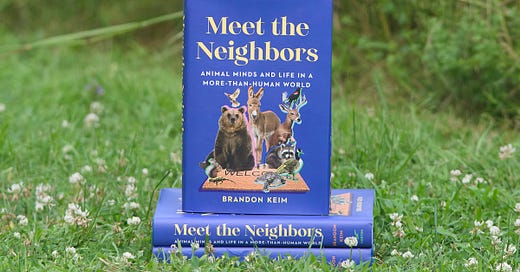Shared Lives, Shared Ecosystems
Clips & ideas from the Substack Live with author Brandon Keim
Thank you to everyone who tuned into my first Substack Live with author
. We spoke about turning to nature in difficult times, emphasizing attunement to seasonal changes and nurturing coexistence with wildlife.Brandon and I first met during a talk we gave together at the Miami Book Fair last fall. In winter, we reunited for a discussion with Project Coyote exploring what animal personhood means legally, ethically and morally as we work toward a world of compassionate conservation and coexistence. Now in spring, our conversation continues as we turn our attention to the rhythms of this season and the awakening of our multi-species communities.
As spring unfolds here in the Northeast, birds migrate back, plants emerge, and queen bumblebees wake from their winter slumber in search of food. We humans, too, shed layers of winter as we reconnect with the warming world around us. These seasonal transitions remind us that we are part of the ecosystem, interconnected with the rhythms of the natural world. Brandon and I explored (among other things) how small, mindful actions can nurture the plants and creatures who share our environment; nurturing us at the same time.
We reflected on the beauty and diversity of overlooked places like vacant lots bursting with pollinators, medicinal plants, and wildflowers, many of them so-called "weeds," like dandelions that hold immense ecological value, inviting us to question why certain plants and animals are maligned.
Because we experienced some technical issues early on (thanks to the old, glitchy phone I refuse to replace), I’m sharing some clips here instead of the full recording.
In the following clip, Brandon shares poignant reflections on bumblebees dreaming atop aster blossoms during their final moments; a beautiful image that inspires deeper thought about the richness of their experiences and the fleeting beauty of their lives.
Here’s one more where some practical tips surfaced like using Acopian Bird Savers to prevent window collisions and adopting humane approaches for small mammals during their baby season.
Here is the rest of what Brandon was sharing above that was cut off:
“Her name is Kathy Pollard, and she lives here in Eastern Maine. She is of mixed Cherokee and Western European ancestry, and a very important part of her cultural sense of self and the values she was raised with is thinking of all animals as persons.
In the gardening and planting she does, she’ll discourage little furry things from chewing on shoots by putting fallen pine branches around newly planted plants—the scent and texture discourage chipmunks and groundhogs from getting in there. She also accepts that some amount of what she's planting will be eaten by other creatures. She talked about how, traditionally, Indigenous nations here would design their gardens so that the outer parts were for deer, and the interior parts were for humans. That vision of sharing and planting for all species is central to her practice.
Much of what she does now is planting native fruit and nut trees, tending areas owned by land trusts, and making them into food gardens for animals. It’s such a beautiful way of being in the world.”
Other tips that emerged in our conversation include planting early spring flowers to support bumblebees and celebrating the underappreciated beauty of early successional landscapes, highlighting their vital ecological roles alongside mature forests.
Reflections like these remind us of the importance of staying attuned to seasonal rhythms and finding ways to coexist compassionately with the many species who enrich our lives and who share our earthly home.
Who are you seeing outside in your local ecosystem?
Coincidentally, and
of The Next Big Idea Club shared my book, Earthly Bodies, and Brandon’s book, Meet The Neighbors in today’s post: “8 Books To Help You Unplug, Unwind, and Get a Little Wild: From building cabins to befriending deer, these thought-provoking reads celebrate the healing, humbling, and awe-inspiring power of the natural world.”If you appreciated this post and conversation, you might also like these spring themed pieces: Wild Rituals, Migration, Spring Ephermals, and Rising With Spring. 🌱






Seemed to be a late spring due to the cold. Typically, in January the bumblebees arrive for the Pieris japonica and early rhododendrons that bloom, though it was February when they arrived. A pair of mallard ducks arrived late winter; and beginning last month we have been visited by a pair of wood ducks. The beautiful, intelligent, hard-working coyote live here year-round, thankfully. Love seeing and hearing them. Deer are plenty. And the fawns will be arriving in May or June. There are red-tailed hawks, finally saw a heron in the pond for the first time in months, pileated woodpeckers, hairy and downy woodpeckers and all the beautiful songbirds: chickadees, black-capped and mountain, Steller's jays; the year-round hummingbirds, rufous and Anna's and more beautiful wildlife. Awe and respect for them, their nature, their home, their wilds.
Young mom doe with twins
munching on the new plantings.
Not our plan, oh well.